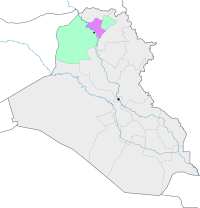Batnaya
| Batnaya ܒܛܢܝܐ | |
|---|---|
 Batnaya | |
| Coordinates: 36°32′15″N 43°7′24″E / 36.53750°N 43.12333°ECoordinates: 36°32′15″N 43°7′24″E / 36.53750°N 43.12333°E | |
| Country |
|
| Governorate | Ninawa |
| District | Tel Keppe |
| Population [1] | |
| • Total | 5,000 |
| Time zone | GMT +3 |
Batnaya or Batnai (Syriac: ܒܛܢܝܐ) is an Assyrian town in northern Iraq, within the Assyrian homeland, located 14 miles north of Mosul and about 3 miles north of Tel Keppe.
Etymology
The name Batnaya is of Aramaic origin, derived from either "Beth Tnyay" meaning, "The House of Mud", or "Beth Tnaya", meaning "The House of Assiduity."
History
Batnaya was attacked by the army of Nader Shah in 1743, who destroyed the village extensively and is believed to have killed half of its inhabitants.
In the past Batnaya used to be famous for making matting from the reeds its people used to cultivate in the valley of al-Khoser river. Currently, some of its inhabitants are cultivating different kinds of crops while others are involved in non-agricultural trades.
In 1944 the Mar Qeryaqos Church was built on the ruins of a monastery by the same name believed to have been built in the early 15th century. A second but smaller church, Mart Maryam, was built in 1966, while the church of Mar Gewargis was mentioned in an inscription dated 1745.
In Batnaya are several inscriptions. One dating to 1545 by Darweesh bin Yohanan from the village of Aqreen is entitled "Prayers for the Dead". Another is a complete bible inscribed in Chaldaya by the priest Ataya bin Faraj bin Marqos of Alqosh, dating to 1586.
As with all the other currently Assyrian villages that belong to the Chaldean Catholic Church, Batnaya's Assyrian Catholic population used to follow the Church of the East until the sixteenth century, when the efforts of the Catholic Church came to fruition and the Church of the East was divided. However, as is the case with all the other villages of the Nineveh Plains, Catholicism did not gain ground till around the mid-18th century.
Currently, the majority of these people live in the United States, Europe, and Australia.
Population
During the 17th and 19th centuries, the town had about 900 people; in 1995, the town grew to about 3,000 people. Prior to the emergence of ISIS, it exceeded over 6,000 people. All the people in the town are Chaldean/Syriac who belong to the Chaldean Catholic Church.
Modern-day Batnaya
In 2007, because of the growth of the town, Sarkis Aghajan built 25 new model houses near the Mar Oraha Monastery, which is beside the town. The provision of municipal services to the village and monastery through the supply of two tractors for harvest and agriculture, and a dumper to collect garbage as well as employment of labourers to clean the access roads in the village, have been established. The village is under full control of Peshmerga, Nineveh Plain Forces and Nineveh Plain Protection Units.
More recently, the village remained mostly untouched by the so-called Islamic State (2014-2016). It was only after the occupation by the Kurdish forces that the homes in the village were sacked and destroyed. Batnaya remains part of Iraq and belongs to its local, indigenous Chaldean inhabitants, some with land deeds passed on by multiple generations. Most men and women work all around farming and basic construction. The families are known for their loyalty, respect and community focus. Even children and the elderly play a major role whether playing, gardening or herding sheep or going to school, mentoring, reading and writing.
Local highlights include "cherrah", a yearly walk around the village around Easter time. This event and the enchanting spring in Northern Iraq generally bring tourists from all over the world, boosting a great secondary retail economy. The residents are known for their welcoming attitude often sitting out front of their homes and often inviting others, even strangers. One could go out at night and play backgammon and smoke hookah. Al-qosh boosts some amazing scenes and is fairly close by.
Language
The people of Batnaya speak Chaldean Neo-Aramaic as their first language; however, some speak Arabic or Kurdish.
See Also
References
- Originally based on an article by betnahrain.net, licensed under the GNU Free Documentation License, used with permission.
- http://www.ishtartv.com/en/viewarticle,35878.html
